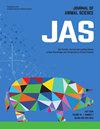91 Delaying fixed-time artificial insemination on the 7-Day CO-Synch + CIDR protocol to incorporate utilization of sex sorted semen in beef cows
IF 2.7
2区 农林科学
Q1 AGRICULTURE, DAIRY & ANIMAL SCIENCE
引用次数: 0
Abstract
The utilization of sex sorted semen allow beef producers to strategically alter their calf crop and select females from which they can generate replacements heifers or steers for terminal crosses. The objective of this study was to determine the effect of insemination time on pregnancy rate of the 7-Day CO-Synch + CIDR fixed-time artificial insemination (TAI) protocol with either sexed sorted or conventional semen on mature beef cows that were detected either in estrus or not. A total of 882 mature beef cows across 8 locations were enrolled in the study. Within location, cows were synchronized using the 7-day CO-Synch+CIDR protocol. Cows were administered GnRH (100 μg) and a CIDR insert [Day -7], PGF (25 mg) injection, CIDR removal and an estrus alert patch [Day 0], and a second injection of GnRH concurrently with TAI [Day 3]. On Day 3, based on estrus alert patch status by 66 hrs, cows were randomly assigned to four treatments: 1) TAI at 66hrs with sex sorted semen (SSAM, n = 272); 2) TAI at 72hrs with sex sorted semen (SSPM, n = 252; 3) TAI at 66hrs with conventional semen (CSAM, n = 195); 4) TAI at 72hrs with conventional semen (CSPM, n = 163). A total of nine technicians performed all inseminations using two sires (either sexed or conventional). Data were analyzed using the GLIMMIX procedure of SAS for binomial data with cow as experimental unit and the fixed effects of treatment, location and the interaction, and the random effect of technician and sire. Pregnancy was diagnosed via transrectal ultrasonography between 60 and 74 days after TAI. Overall estrus response was 59.5%. Cow age (6.2 ± 0.2 yrs) and days postpartum (77 ± 1.3 d) were similar (P > 0.10) among treatments. Pregnancy rate to TAI was similar (P = 0.71) among treatments with 43.0 ± 3.9% for CSAM, 49.6 ± 4.3% for CSPM, 45.7± 3.4% for SSAM, and 45.9 ± 4.1% for SSPM. We conclude that delaying insemination time from 66 to 72 hrs did not affect pregnancy rates of beef cows enrolled in the 7-Day CO-Synch + CIDR TAI protocol and inseminated with sex sorted or conventional semen. In addition, TAI pregnancy rate was similar between semen types, when sex sorted semen was used in females detected in estrus and conventional semen was used in females not detected in estrus.91在7天co - sync + CIDR方案上延迟固定时间人工授精,以纳入对肉牛性别分类精液的利用
利用性别分类的精液,牛肉生产者可以战略性地改变他们的小牛作物,并从中选择雌性,他们可以为最终杂交产生替代的小母牛或阉牛。本研究的目的是确定授精时间对7天CO-Synch + CIDR固定时间人工授精(TAI)方案的受孕率的影响,该方案采用性别分选的精液或常规精液,对处于发情期或未处于发情期的成熟肉牛进行人工授精。共有8个地点的882头成年肉牛参加了这项研究。在现场,奶牛使用7天co - sync +CIDR协议进行同步。奶牛注射GnRH (100 μg)和CIDR插入剂[第7天],PGF (25 mg)注射,CIDR去除和发情警示贴[第0天],第二次注射GnRH同时注射TAI[第3天]。在第3天,根据66h的发情警报斑块状态,将奶牛随机分为4个处理:1)在66h时进行TAI处理,使用性别分类的精液(SSAM, n = 272);2) 72小时TAI,精液性别分类(SSPM, n = 252;3)用常规精液进行66小时TAI (CSAM, n = 195);4)使用常规精液(CSPM, n = 163)进行72小时TAI。共有9名技术人员使用两种试管(性别或常规)进行所有人工授精。采用SAS软件的GLIMMIX程序对二项数据进行分析,以奶牛为实验单位,处理、位置和相互作用的固定效应以及技术人员和奶牛的随机效应。经直肠超声检查于TAI后60 ~ 74天诊断妊娠。总体发情反应为59.5%。奶牛年龄(6.2±0.2年)和产后天数(77±1.3 d)相似(P >;0.10)。两组妊娠率相似(P = 0.71), CSAM组为43.0±3.9%,CSPM组为49.6±4.3%,SSAM组为45.7±3.4%,SSPM组为45.9±4.1%。我们得出的结论是,将受精时间从66小时推迟到72小时对7天co - sync + CIDR TAI方案中使用性别分类或常规精液进行受精的肉牛的妊娠率没有影响。此外,在不同类型的精液中,在发情的雌性使用性别分类的精液,而在未发情的雌性使用常规精液时,TAI妊娠率相似。
本文章由计算机程序翻译,如有差异,请以英文原文为准。
求助全文
约1分钟内获得全文
求助全文
来源期刊

Journal of animal science
农林科学-奶制品与动物科学
CiteScore
4.80
自引率
12.10%
发文量
1589
审稿时长
3 months
期刊介绍:
The Journal of Animal Science (JAS) is the premier journal for animal science and serves as the leading source of new knowledge and perspective in this area. JAS publishes more than 500 fully reviewed research articles, invited reviews, technical notes, and letters to the editor each year.
Articles published in JAS encompass a broad range of research topics in animal production and fundamental aspects of genetics, nutrition, physiology, and preparation and utilization of animal products. Articles typically report research with beef cattle, companion animals, goats, horses, pigs, and sheep; however, studies involving other farm animals, aquatic and wildlife species, and laboratory animal species that address fundamental questions related to livestock and companion animal biology will be considered for publication.
 求助内容:
求助内容: 应助结果提醒方式:
应助结果提醒方式:


